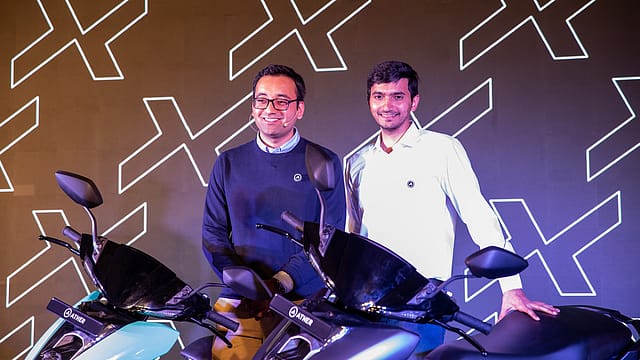Ather Energy eyes profitability, IPO in 18-24 months
ADVERTISEMENT

Electric two-wheeler startup Ather Energy aims to turn profitable in the next 18-20 months as it looks for an IPO about that time—or earlier. Ather is banking on doubling the volumes with the launch of a family scooter next year. A scooter for the mass market has been a gap in its portfolio.
"Our business will need capital for another 18-24 months before becoming profitable. The company also plans to go public around the same time or maybe faster," says Ather co-founder and CEO Tarun Mehta.
Mehta expects the company's cash burn for FY24 to be the same or lower than FY23. "We have lost roughly ₹400 crore due to subsidy cuts this year but our burn would still be the same as last year which is about ₹700-800 crore."
Ather is likely to raise one more round of funding as a private company before launching an IPO.
The electric vehicle manufacturer plans to launch a family scooter next year, marking its entry into a segment that constitutes nearly 80% of the market. "All this while, we have been playing this game one hand behind our back because we don't have a product for the largest market. The upcoming family scooter will have a large seat, a big storage area, and more legroom," says Mehta.
December 2025
The annual Fortune 500 India list, the definitive compendium of corporate performance, is out. This year, the cumulative revenue of the Fortune 500 India companies has breached $2 trillion for the first time. Plus, find out which are the Best B-schools in India.
The introduction of a family scooter is expected to double the volumes for Ather, says Mehta. The company's existing product portfolio comprises only sporty scooters that cater to a niche market.
Following the FAME-II (Faster Adoption of Manufacturing of Electric Vehicles in India) subsidy cut in June, Ather had to undertake a lot of design and platform changes to improve margins. "A lot of this was planned but subsidy reduction forced us to fast-track it," the Ather CEO says.
The business has shown resilience despite the government slashing subsidies on electric two-wheelers by 70%. "When subsidies came down, they reduced our margins by almost ₹35,000 per scooter. In the last few months, we have been able to catch up with all of it. Earlier ₹55,000 margin came from subsidies for a scooter worth ₹1.25 lakh. Now, the subsidy is only ₹20,000 but margins have fully recovered," says Mehta.
Ather's sales dropped to under 6,000 units in June due to the subsidy cut. But it bounced back to over 9,000 units in November. By March 2024, Mehta expects sales to recover to 13,000 units per month—its peak before the subsidy was partially rolled back.
The government slashed incentives on electric two-wheelers to ₹10,000 per kWh from ₹15,000 per kWh earlier. The cap on sops was fixed at 15% of the ex-factory price of EVs as against 40% earlier.
Mehta believes the industry is not in a place where it can work with zero subsidy. "Already, we have had three quarters of lost growth this year. You don't want another year of lost growth which will slow down the momentum further," he cautions.
"The sudden 70% subsidy cut hurt the industry. If this had been done gradually over two years, the industry would not have had a problem. A lot of customers didn't buy an EV this year because they were uncertain due to sudden changes in prices," Mehta explains.
The Ather CEO, however, agrees that subsidies should be tapered down. "It is a bad idea to keep the industry at the same subsidy level for a prolonged period because that brings down innovation."
On Thursday, India's largest two-wheeler maker Hero MotoCorp increased its stake in Ather to 39.7% from 36.7% earlier. Hero will invest another ₹140 crore to buy additional shares of Ather from an existing shareholder.
Even though Hero MotoCorp is the largest strategic shareholder of Ather, the two companies don't have tie-ups beyond charging. In terms of operations, both have separate stores, R&D centres, supply chains, distribution and products.
Ather operates India's largest fast-charging network for electric two-wheelers called the 'Ather Grid'. The company has set up over 1,400 chargers across the country so far and opened up its chargers to other OEMs.
Hero MotoCorp is already using its charging network. "There are at least 5-6 more OEMs who are on their way to adopting it. Their design teams are working with ours to finish testing," says Mehta.
Ather's charging network is a big carrot for a lot of smaller start-ups. "Once you see some companies come on board, at least some of the other three large OEMs will also flip. That's pretty much what the national standard is then," says Mehta, referring to Ather's charging standard. Ather's locally-developed connector for light electric vehicles was recently recognised by the Bureau of Indian Standards (BIS).
India currently has over 25 crore two-wheelers on the roads. The Centre is eyeing 100% of new two-wheeler sales to be electric by 2030 from 5% currently. There are about 25,000 retail touch points for petrol-powered two-wheelers but for EVs the number is less than 3,000.
Incorporated in 2013, Ather is the third-largest electric scooter producer after market leader Ola Electric and TVS. Both Ola and TVS have over 1,000 retail touch points each for EVs while Ather has 180 stores. "We need to catch up a lot. We should be able to get to 300 stores in six months," Mehta says.
